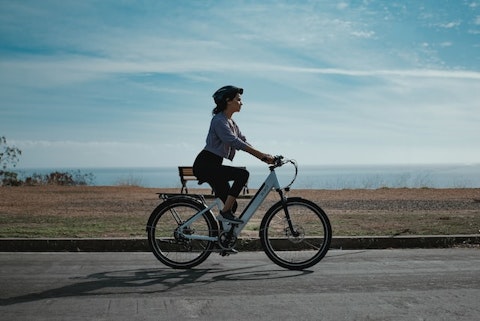In this article, we will take a look at the 20 best US cities to live without a car. If you want to skip our discussion on shifting consumer preferences, you can go directly to the 5 Best US Cities To Live Without A Car.
Due to the high interest rates as well as the rising price of gas and maintenance of cars, many Americans want to go carless. A survey by Zipcar has revealed that about 35% of adults in the US are ready to forgo car ownership by 2030. This growing trend is not isolated, as around 44% of all adults shared that they are already acquainted with someone successfully navigating life without owning a car. Furthermore, there is a notable variation in the perceptions of each generation regarding the decline in future car ownership. Around 45% of Gen Z and 51% of Millennials have shown a willingness to embrace a car-free lifestyle compared to 28% of Gen X and 21% of Boomers. Meanwhile, among college students, around 45% have expressed the likelihood of forgoing a vehicle by 2030. Shifting to a car-free lifestyle is not only easy on the wallet but is also good for the environment and public health. Less car usage will ultimately lead to a reduction in carbon footprint, less energy consumption, and a downward trend in driver stress. It can also improve productivity by reducing the amount of time lost in traffic congestion. In 2022, an average American lost around 50 hours being stuck in traffic, according to the 2022 Global Traffic Scorecard.
Owing to the shifting preferences, the bicycle industry is expected to grow at a compound annual growth rate of 4.2%, from $53.9 billion in 2023 to $66.22 billion in 2028. The bicycle market has experienced its most substantial growth in the Asia-Pacific region, with leading countries such as China, Australia, Japan, South Korea, and India driving this expansion. India recorded the highest percentage of regular cyclists during 2022. Following closely were China and the Netherlands, where approximately two-thirds of the population engaged in weekly bicycle riding. Additionally, nations across Europe have also actively hosted various cycling tournaments, contributing to the rising popularity and demand for sports bicycles. Among the best cities to live without a car in the world in Europe include Paris, Copenhagen, and Amsterdam. Meanwhile, some of the best US cities where you don’t need a car to live include Boston and Newark. You can also read about the 15 Most Walkable Cities in the US here. In addition to bicycles, the demand for electronic bikes has also seen an increase in the recent past. Notable companies like Uber (NYSE:UBER), Lyft (NASDAQ:LYFT), and Bird (NYSE:BRDS) have also ventured into the bike rental services sector.
It is important to note that living without a car is not only a matter of personal preference but is also influenced by one’s place of residence. In areas with limited public transportation and few alternative mobility options, car ownership becomes a necessity. Hence, it is no surprise that 92% of American households still own a vehicle, as per the latest US census. Moreover, vehicle sales actually went up by 2.6% in November 2023 as compared to October 2023 and by 8.8% compared to November 2022. Data also revealed that seasonally adjusted annualized sales of light commercial vehicles in November 2023 were 15.54 million units in comparison to 14.36 million units a year ago.

Photo by KBO Bike on Unsplash
Our Methodology
To shortlist the 20 best US cities to live without a car, we analyzed data from Coworking cafe. The platform conducted a market study that surveyed 331 cities across the country with a population of more than 100,000. The cities were evaluated on nine key metrics, including the percentage of the population using public transportation, walking, and cycling for commuting, as well as the use of taxis, motorcycles, or other vehicles. Additional factors considered included station density and average fare for adults. To enhance the reliability of our findings, we cross-referenced the information with insights gathered from Reddit threads and City-Data.com. The cities have been ranked in ascending order of their total points, ranging from 0 to 100, reflecting their suitability for car-free living.
By the way, Insider Monkey is an investing website that tracks the movements of corporate insiders and hedge funds. By using a similar consensus approach, we identify the best stock picks of more than 900 hedge funds investing in US stocks. The top 10 consensus stock picks of hedge funds outperformed the S&P 500 Index by more than 140 percentage points over the last 10 years (see the details here). Whether you are a beginner investor or professional one looking for the best stocks to buy, you can benefit from the wisdom of hedge funds and corporate insiders.
Best US Cities To Live Without A Car
20. St. Louis, MO
Total Points: 33.2
Percentage of Population Commuting by Public Transportation: 6.5%
Percentage of Population Commuting by Walking: 4.4%
St. Louis, MO, has a strong public transport system. In fact, its light rail system, MetroLink, has been ranked among USA’s best mass transit systems. It has various stops and lines within the city, which make this mode of public transport quite convenient for commuters. This city’s bus service is also among the preferred modes of transportation. Additionally, the city has many pedestrian-friendly neighborhoods and biking trails for people who prefer walking or riding a bike.
19. Buffalo, NY
Total Points: 33.6
Percentage of Population Commuting by Public Transportation: 9.1%
Percentage of Population Commuting by Walking: 5.5%
Buffalo, NY, is another city where you can travel easily without a car, thanks to its public transport system. It has the Niagara Falls Transit Authority for Erie and Niagara counties. The city is bike-friendly, especially during the warmer months, with dedicated bike lanes on its busiest streets and many parking spots for bicycles.
18. Eugene, OR
Total Points: 34.0
Percentage of Population Commuting by Public Transportation: 3.7%
Percentage of Population Commuting by Walking: 5.6%
In Eugene, OR, all commercial, residential, and recreational facilities are easily accessible within walking or biking distance. Several initiatives are being implemented within the city to promote ’20-minute living,’ an idea that individuals should be able to fulfill their essential needs within a convenient 20-minute walk. Furthermore, the city’s bus service, which is operated by the Lane Transit District, serves most of the areas within the city at affordable rates.
17. Ann Arbor, MI
Total Points: 34.2
Percentage of Population Commuting by Public Transportation: 8.1%
Percentage of Population Commuting by Walking: 15.5%
Ann Arbor is another ’20-minute’ town where people can reach most of their destinations within this time frame. It is also very easy to travel by bicycle within Ann Arbor as it has special bike lanes and paths. Furthermore, the Ann Arbor Transit Authority (AATA) operates an extensive bus system within the city.
16. Arlington, VA
Total Points: 35.5
Percentage of Population Commuting by Public Transportation: 21.6%
Percentage of Population Commuting by Walking: 4.6%
Arlington boasts a robust public transport system. One can easily travel from Arlington to Washington, DC, and adjacent areas by bus or Greater DC Metro. Additionally, bike lanes and trails make it a great place for bikers.
15. Salt Lake City, UT
Total Points: 35.6
Percentage of Population Commuting by Public Transportation: 6.4%
Percentage of Population Commuting by Walking: 4.8%
Salt Lake City has a vast public transport system that allows locals and tourists to travel through the city easily. Among the options for public transport within Salt Lake City are Valley Metro Rail, Frontrunner Commuter Train, and UTA Buses. Apart from this, bike lanes and a bike-sharing program exist within the city.
14. Alexandria, VA
Total Points: 36.8
Percentage of Population Commuting by Public Transportation: 16%
Percentage of Population Commuting by Walking: 3.4%
In Alexandria, VA, a considerable number of people choose to travel on foot instead of driving a car. This is possible as the city has many lanes and paths for walkers as well as bike riders. There are four Metrorail stations within Alexandria, VA, making traveling within and outside the city easy for locals. Additionally, there are four bus options as well.
13. Minneapolis, MN
Total Points: 37.5
Percentage of Population Commuting by Public Transportation: 10.1%
Percentage of Population Commuting by Walking: 6.6%
There are plenty of options to get around Minneapolis, MN, that don’t involve owning a car. Firstly, there are many public transport alternatives, from light rail to buses to ride-sharing services. In addition to this, Minneapolis is one of the most walkable cities in the state of Minnesota due to the presence of its skyway system.
12. Chicago, IL
Total Points: 37.6
Percentage of Population Commuting by Public Transportation: 23.4%
Percentage of Population Commuting by Walking: 5.8%
Chicago, IL, is another city with an extensive public transport system. This system is run by the Chicago Transport Authority and serves the urban stomping grounds and the suburbs. There are 2 public options within Chicago, IL, namely The Chicago L or The Chicago Bus Service. Those who love to walk can take advantage of the city’s Pedway, which is a system of tunnels in Central Chicago. During summers, locals can also make use of the extensive bike paths throughout the city.
11. Portland, OR
Total Points: 37.6
Percentage of Population Commuting by Public Transportation: 9.6%
Percentage of Population Commuting by Walking: 5.1%
With plenty of walkable neighborhoods and a wide network of bike lanes, Portland, OR, has also made it to the list of best US cities to live without a car. Apart from the active transport options, the city has a reliable public transit system consisting of TriMet’s five rail lines and 85 bus lines.
10. Pittsburgh, PA
Total Points: 37.8
Percentage of Population Commuting by Public Transportation: 15.1%
Percentage of Population Commuting by Walking: 9.7%
Although Pittsburgh has a limited public transit system and does not rank high on walkability, it is quite compact. This makes it easy to access different amenities across the city, even if one doesn’t have a car. Moreover, the travel time for users of public transport is approximately the same as that for car users in the city.
9. Madison, WI
Total Points: 38.2
Percentage of Population Commuting by Public Transportation: 7.1%
Percentage of Population Commuting by Walking: 8.9%
Madison has a very high percentage of residents who prefer to walk or ride a bicycle as a mode of traveling. The city’s bike lane density is one of the highest in the country. Thus, it is among the best cities for bicycling in the US. Madison also has an excellent bus service, operated by Madison Metro, for people traveling through the city and surrounding suburbs.
8. Oakland, CA
Total Points: 39.5
Percentage of Population Commuting by Public Transportation: 18.8%
Percentage of Population Commuting by Walking: 3.7%
Oakland has reliable public transport provided by the Bay Area Transit (BART) system. It has a network throughout the Bay Area and is connected to commuter rail extending from Sacramento all the way to Southern California. Furthermore, it is the seventh most walkable city in the US, according to Walkscore.com.
7. Seattle, WA
Total Points: 41.3
Percentage of Population Commuting by Public Transportation: 17.8%
Percentage of Population Commuting by Walking: 9.7%
Seattle has two major providers of public transit, namely King County Metro Transit and Sound Transit. Both work together to provide bus and rail travel services to commuters within the city. Cycling and walking are also preferred modes of travel by many residents within this Northwestern city, and there are many parks, cycling clubs, and cycling shops that promote active modes of travel. The city is in seventh place on our list of the 20 best US cities to live without a car.
6. Philadelphia, PA
Total Points: 42.0
Percentage of Population Commuting by Public Transportation: 21.4%
Percentage of Population Commuting by Walking: 7.6%
Many people in Philadelphia use SEPTA trains and buses for their traveling needs. The bus, train, and metro station density within the city is amongst the highest in the US, with two stations per square mile. Philly is also great for bikers due to its numerous bike lanes and the presence of a bike-sharing service. Moreover, the city has the 5th highest walkability score across the country.
Owing to changing consumer preferences, popular companies like Uber (NYSE:UBER), Lyft (NASDAQ:LYFT), and Bird (NYSE:BRDS) have ventured into the bike rental services sector. These companies are strategically diversifying their services beyond traditional car-based platforms to embrace alternative modes of transportation.
Click to continue reading and see the 5 Best US Cities To Live Without A Car.
Suggested articles:
- 20 Countries with Most Cars Per Capita in the World
- 24 Countries With Biggest Population Decline
- 20 States With the Smallest Gender Pay Gap in 2023
Disclosure: None. 20 Best US Cities To Live Without A Car is originally published on Insider Monkey.





